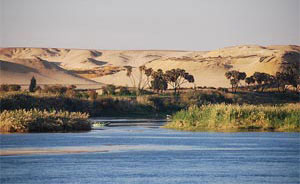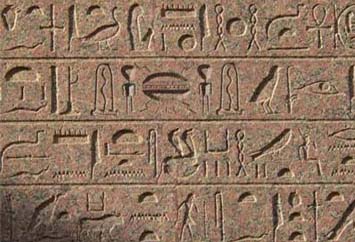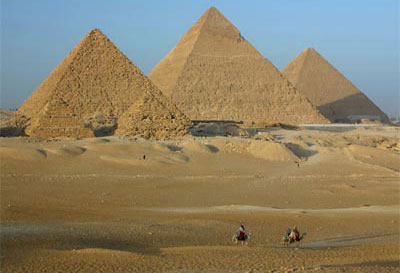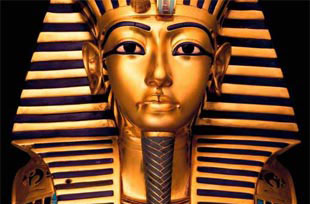Ancient Egypt
Ancient Egyptian life

For almost 30 centuries - from its unification around 3100 BC to its conquest by Alexander the Great in 332 BC - ancient Egypt was the pre-eminent civilization of North-eastern Africa, which formed along the banks of the River Nile in what is now the modern day Egypt.
Daily life in ancient Egypt revolved around the Nile and the fertile land along its banks. The yearly flooding of the Nile enriched the soil and brought good harvests and wealth to the land.
The people of ancient Egypt built mudbrick homes in villages and in the country. They grew some of their own food and traded in the villages for the food and goods they could not produce.
Most ancient Egyptians worked as farmers, craftsmen and scribes. A small group of people were nobles. Together, these different groups of people made up the population of ancient Egypt.
Egyptian writing

The Egyptian writing called hieroglyphics used pictures to represent different objects, actions, sound or ideas. There were more than 700 hieroglyphs. Some pictures stood for whole words.
Hieroglyphs is made from two Greek words, hieros meaning holy and glyphe meaning writing. It was first used by Clement of Alexandria.
The earliest known examples of writing in Egypt have been dated to 3400 BC. The latest dated inscription in hieroglyphs was made on the gate post of a temple at Philae in 396 AD.
Throughout three thousand years of ancient Egyptian civilisation, at least three other scripts were used for different purposes. Using these scripts, scribes were able to preserve the beliefs, history and ideas of ancient Egypt in temple and tomb walls and on papyrus scrolls.
Egyptian pyramids & temples

Built on a massive scale, the pyramids of ancient Egypt are some of the most magnificent man-made structures in history.
Ancient Egyptians built pyramids to hold the royal tombs of their kings. It had storage rooms, courtyards, secret passageways, and all kinds of clever traps designed to catch robbers who tried to break into the pyramid to rob it.
The first pyramid, the Step Pyramid, was built around 2700 BC.There are about eighty pyramids known today from ancient Egypt. The three largest and best-preserved of these were built at Giza at the beginning of the Old Kingdom. The most well-known of these pyramids was built for the pharaoh Khufu. It is known as the 'Great Pyramid' and is over 140 m (459 ft) high and took 20 years to build.
Pharaohs

A Pharaoh was the most important and powerful person in the kingdom. The pharaoh was the political and religious leader of the Egyptian people, holding the titles: 'Lord of the Two Lands' and 'High Priest of Every Temple'. Most pharaohs were men but some well-known pharaohs, such as Nefertiti and Cleopatra, were women.
The first true pharaoh of Egypt was Narmer (sometimes called Menes), who united Lower Egypt and Upper Egypt. He was the first king of the First Dynasty, the beginning of the Old Kingdom.
Egypt was once divided into two kingdoms. The kingdom in Lower Egypt was called the red crown and the one in Upper Egypt was known as the white crown.
Around 3100 BC King Narmer of the north conquered the south and Egypt became united. He founded the first capital of Egypt where the two lands met. It was called Memphis. (Thebes became the next capital of Egypt and then Amarna was made the capital during the reign of King Akhenaten.)
The most famous Egyptian pharaoh is Tutankhamun or King Tut, who ruled Egypt as pharaoh for about 10 years at the tender age of nine in 1337 BC. The reason that Tutankhamun is so well known today is that his tomb, containing fabulous treasures, was found early this century (1922) by British archaeologists Howard Carter and Lord Carnarvon.
Gods & Goddesses

The ancient Egyptians believed in many different gods and goddesses. Each one with their own role to play in maintaining peace and harmony across the land.
Some gods and goddesses took part in creation, some brought the flood every year, some offered protection, and some took care of people after they died. Others were either local gods who represented towns, or minor gods who represented plants or animals.
The ancient Egyptians believed that it was important to recognise and worship these gods and goddesses so that life continued smoothly.
Mummification

It was very important to ancient Egyptian religious beliefs that the human body was preserved. A method of artificial preservation, called mummification was developed by the ancient Egyptians. Mummification was a complicated and lengthy process which lasted up to 70 days.
The Egyptians believed in life after death. They believed that they had to preserve their bodies so they could use them in the afterlife.
The process of mummification had two stages. First the embalming of the body and then the wrapping and burial of the body.
It took a very long time, from start to finish, it took about 70 days to embalm a body. The priest in charge would wear the mask of a jackal representing the god Anubis.
- The body was washed and purified.
- Organs were removed. Only the heart remained.
- The body was filled with stuffing.
- The body was dried by covering it with a substance called natron. This substance absorbed all the moisture from the body.
- After 40 - 50 days the stuffing was removed and replaced with linen or sawdust.
- The body was wrapped in strands of linen and covered in a sheet called a shroud.
- The body was placed in a stone coffin called a sarcophagus.